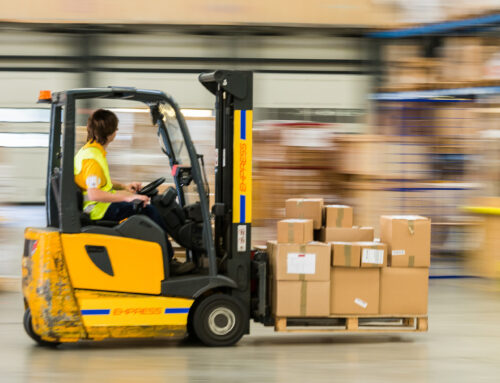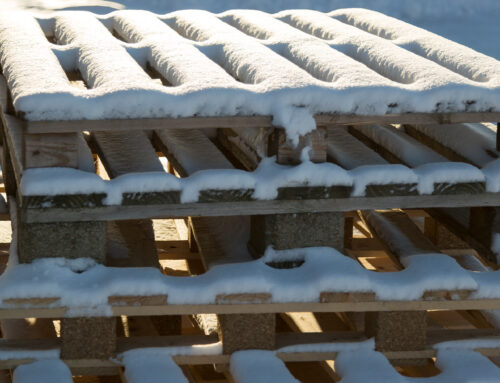The weather is getting warmer across the country, and that means manufacturers have to be on the lookout for pallet mold. While some industries, like food, beverage, and pharmaceutical, have to be super cautious about mold on their pallets, spring is the time where pallet mold can get out of control for everyone.
Starting as only a few spores, spring conditions can cause spores to quickly colonize and contaminate pallets, products, and equipment. It can also create a problem for employee health and consumer safety if not managed effectively.
What is Pallet Mold?
Pallet mold is a type of fungus that produces pigmented spores that feed off of and grow on the surface of wood products, as well as other materials. Some spores are visible as black, white, orange, purple, or green spots, while others are difficult to see. Spores can be airborne and easily spread not only on wood, but on other surfaces as well.
It’s not always easy to identify pallet mold, however. Sometimes simple wood staining is mistaken for pallet mold, so it’s important to find out if it’s really mold or just staining.
What Causes Pallet Mold?
Pallets can be exposed to mold spores in a wide variety of ways, from the mill where the wood is produced, to your very own manufacturing facility. It really doesn’t matter so much how your pallet is exposed, as much as it matters that you reduce the conditions that encourage mold growth.
Mold spores require four key elements in order to take root, survive, and grow:
1. Moisture: Pallet mold must have moisture to grow. Wood with greater than 19% moisture encourages spore growth, and pallets stored in locations with higher than 60% humidity have a much greater chance of becoming contaminated. With spring conditions upon us, many pallets are being exposed to more moisture than normal.
2. Oxygen: Mold spores require oxygen to grow. Obviously, no one can control oxygen unless you’re vacuum-sealing your pallets or locking them in a vault.
3. Warmer Temperatures: As we’re heading into Spring, things are definitely warming up. While some pallet molds are capable of growing under a wide range of temperatures, spores multiply best in warm temperatures. The ideal temperature for pallet mold growth is between 70 and 85 degrees Fahrenheit.
4. A Food Source: Mold can grow on a wide variety of materials and use those materials as a food source. In wood pallets, mold spores use the structural polymers, sugars, and proteins in the wood as fuel for growth. Mold can also feed on the products that are stored on your pallets. Nearly anything that contains natural sugars and proteins can become food for mold, including apparel, food & beverage products, pharmaceutical products, toys, household items, etc.
Does Heat Treatment Prevent Pallet Mold?
One of the most common misconceptions about pallet mold is that kiln drying or ISPM15 heat treatments will prevent mold from forming. Unfortunately, neither of those things are true.
Kiln drying is the process of treating wood during processing, where the moisture is removed and the wood is cured. This is what makes the wood ready for use as pallets, crates, and various other things. While this process does remove moisture, generally down to the under 19% level, it does not prevent mold from growing on the wood in the future. Once your pallets are exposed to the right combination of moisture and temperature, the conditions will be right for mold growth.
On the other hand, ISPM15 treatment is designed to kill insects living in the wood to prevent pests from being transported internationally. Some claim that ISPM15 treatment actually draws moisture and sugars to the wood, and can actually make matters worse for mold.
Is It Actually Mold?
It can be very easy to mistake wood staining for pallet mold. Just because you see dark spots or discoloration, doesn’t mean that your pallets have mold.
Wood discolorations and staining can be caused by sun exposure, naturally occurring enzymes, minerals, fasteners, or even generate from the wood itself. In general, wood staining and discoloration do not affect the durability or usability of your pallets.
How to Prepare Your Pallets for Spring Mold Season
The best way to keep mold away from your pallets is to limit the conditions that cause mold to grow and spread. For the most part, keeping your pallets dry is your best bet. Here are the best practices for limiting pallet mold:
- Don’t leave pallets stored in a trailer. Dark, warm, and humid is the perfect incubator for mold growth. Pallets should be unloaded as soon as possible.
- When possible, store pallets indoors in a cool, dry, well-ventilated place.
- Keep your pallets out of the rain and wet weather conditions. If you can’t store them in a covered location, try to cover them with tarps during bouts of rain and remove the tarps once the weather is cleared. Leaving pallets covered by tarps puts you back in that dark, warm, and humid territory again.
- If possible, elevate pallets off the ground so that they aren’t sitting in puddles or run-off.
- No matter if pallets are stored indoors out outside, make sure that rows are spaced far enough apart to allow for circulation.
If all else fails, and you still find pallet mold, there are ways to remediate the mold and save your pallets. Spring is definitely here, but it doesn’t have to ruin your pallets.







